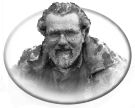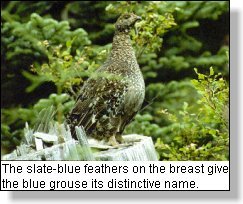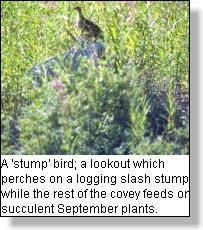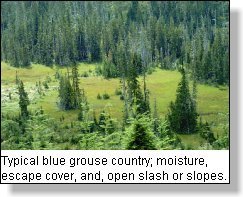
B.C. OUTDOOR ODYSSEY
"BRITISH COLUMBIA'S BOUNTIFUL BLUE GROUSE"
with Barry M. Thornton
 Have you ever wondered why, in the spring or early summer, you have
had that tooth vibrating experience while walking in the woods: why
your teeth seem almost to vibrate from some deep outdoor resonating
sound? It is highly likely that you have been walking near a calling
stump, a 'hooting log' of one of British Columbia's legendary upland
game birds, the blue grouse. During the spring the male blue grouse
selects a 'hooting' location, usually a stump, log or tree, from which
they will call the females. The call has been referred to as a "ventriloquistic
courtship call," and can be heard for miles when conditions are right.
Anyone who has been in the  vicinity
during this period can recall, yes, even feel the vibrations of this
deep low resonant sound of the cock bird. 'Hens' will respond to the
'Hooters' and, following mating, they will search out an open meadow
(open slash) site where they will brood their clutch of eggs for about
one month. The young are precocial, that is, they are able to run
around shortly after hatching and will scratch and feed themselves
as they follow the hen. vicinity
during this period can recall, yes, even feel the vibrations of this
deep low resonant sound of the cock bird. 'Hens' will respond to the
'Hooters' and, following mating, they will search out an open meadow
(open slash) site where they will brood their clutch of eggs for about
one month. The young are precocial, that is, they are able to run
around shortly after hatching and will scratch and feed themselves
as they follow the hen.
British Columbia has two major species of blue grouse, COASTAL &
INTERIOR (Bendell and Zwickel 1984), which are classified into eight
subspecies, three of which inhabit B.C. Blue Grouse are a species
of grouse which inhabit forested areas of the Rocky Mountains and
the Pacific Coastal Ranges as far south as California and Colorado
and as far north as the Yukon. B.C. however, has well over 50% of
the world's population of blue grouse. They can be found in all areas
of the province except the far north-east, the northern Chilcotin-Cariboo,
and most of the Boreal Forest. The greatest abundance appears to be
on the east coast of Vancouver
Island. Blue grouse are cyclical so the total number in the province
is estimated to vary between 500,000 and 1,500,000 birds annually.
 Blue
grouse tend to have large clutch numbers of eggs, up to fifteen, although
6 to 10 is the average. Hatching success is high most years, up to
90%. But, of those which hatch, mortality is usually 50% prior to
the fall hunting season. This mortality is usually caused by cold,
wet weather just after hatching, insufficient food, and predators.
How often have you heard upland game bird hunters and wildlife biologists
discuss the "Wet spring," or the "Wet June," when they meet and talk
about this challenging and exciting upland game bird! They know that
the inclement weather at that time of the year will dictate their
overall hunting success in the Fall. Blue
grouse tend to have large clutch numbers of eggs, up to fifteen, although
6 to 10 is the average. Hatching success is high most years, up to
90%. But, of those which hatch, mortality is usually 50% prior to
the fall hunting season. This mortality is usually caused by cold,
wet weather just after hatching, insufficient food, and predators.
How often have you heard upland game bird hunters and wildlife biologists
discuss the "Wet spring," or the "Wet June," when they meet and talk
about this challenging and exciting upland game bird! They know that
the inclement weather at that time of the year will dictate their
overall hunting success in the Fall.
For many years the blue grouse had the misnomer of "FOOL-HEN," a
disparaging name which in truth belongs to a cousin, the spruce grouse,
another native of the B.C. forests. However, that is not to say that
the name does not fit at times. Often a flushed blue grouse will land
on an evergreen bough and simply freeze, even though you may be able
to walk within a few feet of where they perch on a branch.
The blue grouse has an unique migration habit, they are vertical
migrators who in recent years have, in those areas where there is
intensive logging, reversed their historic migration pattern. In those
mountains where logging has cleared vast tracks of forests, blue grouse
nest in the cleared slash areas and in winter migrate uphill to the
uncut remaining evergreen forests. Historically they migrated downhill
from open mountain slopes and meadows.
 For
most of the year blue grouse live in coniferous forests feeding exclusively
on evergreen needles. In July the cock birds will migrate from the
breeding location, usually uphill if it is an open slash area. Recently
it has been noted that logging practice are now often above the 1000
meter level and hooters have been found to migrate downhill to new
second growth forested areas. Because of this early summer migration,
the mature male population in the hunter harvest is very low, comprising
less than 6% of the total harvest. The hen with her brood remain in
open areas feeding on berries and plants until early in September.
At that time, usually following an intense late summer storm, leading
her brood, she will begin a slow migration towards a heavily forested
area. The movement of one group often triggers other family groups
who will join with the first creating an immense flock of migrating
birds. The migration may take a few days depending on a number of
factors, including weather, distance and food. Should you chance upon
these migrating flocks it will be one of nature's sights and experiences
that you will never forget. Grouse will be everywhere, on the ground,
in the trees and shrubs, and in every direction wherever you look.
Once they reach the evergreen forests blue grouse change their diet
from the succulent tips of plants and berries to evergreen needles. For
most of the year blue grouse live in coniferous forests feeding exclusively
on evergreen needles. In July the cock birds will migrate from the
breeding location, usually uphill if it is an open slash area. Recently
it has been noted that logging practice are now often above the 1000
meter level and hooters have been found to migrate downhill to new
second growth forested areas. Because of this early summer migration,
the mature male population in the hunter harvest is very low, comprising
less than 6% of the total harvest. The hen with her brood remain in
open areas feeding on berries and plants until early in September.
At that time, usually following an intense late summer storm, leading
her brood, she will begin a slow migration towards a heavily forested
area. The movement of one group often triggers other family groups
who will join with the first creating an immense flock of migrating
birds. The migration may take a few days depending on a number of
factors, including weather, distance and food. Should you chance upon
these migrating flocks it will be one of nature's sights and experiences
that you will never forget. Grouse will be everywhere, on the ground,
in the trees and shrubs, and in every direction wherever you look.
Once they reach the evergreen forests blue grouse change their diet
from the succulent tips of plants and berries to evergreen needles.
 Blue
grouse food is so variable that it cannot be used as a locator should
you wish to find flocks of these chicken sized birds. However, as
grouse are gallinaceous, 'scratching birds' their crops require grit,
the small gravel they use for their crops to grind food. The profusion
of gravel roads throughout the province are a great attraction for
grouse and makes these prime areas to locate birds. A slow drive along
most British Columbia mountain roads is a quick way to locate blue
grouse. On occasion coveys of hooters can be seen in special habitat.
These much larger birds are usually found on steep slopes or rocky
bluffs having panoramic views overlooking mountain valley areas. Blue
grouse food is so variable that it cannot be used as a locator should
you wish to find flocks of these chicken sized birds. However, as
grouse are gallinaceous, 'scratching birds' their crops require grit,
the small gravel they use for their crops to grind food. The profusion
of gravel roads throughout the province are a great attraction for
grouse and makes these prime areas to locate birds. A slow drive along
most British Columbia mountain roads is a quick way to locate blue
grouse. On occasion coveys of hooters can be seen in special habitat.
These much larger birds are usually found on steep slopes or rocky
bluffs having panoramic views overlooking mountain valley areas.
Liberal game bags and a lengthy hunting season are a B.C. tradition
for this province wide upland game bird species. "Hunting mortality
tends to replace other mortality and is not additive." This statement
from the Ministry of Environment, the managers of blue grouse, summarizes
the reasons for these liberal limits and lengthy seasons. In discussions
I have had with Dr. Zwickel, he indicated that hunters harvest only
about 4% of blue grouse populations and are not a factor in their
population.
Blue grouse are birds of the high and mid mountain areas. It is while
I am hiking on these mountain ridges, following the steep grassy slopes
or cleared slash areas, and, marvelling at the vista in front of me,
that I truly appreciate this special British Columbia mountain legend,
the blue grouse.
"The End"
© Copyright Barry M. Thornton
Barry M. Thornton
|





 vicinity
during this period can recall, yes, even feel the vibrations of this
deep low resonant sound of the cock bird. 'Hens' will respond to the
'Hooters' and, following mating, they will search out an open meadow
(open slash) site where they will brood their clutch of eggs for about
one month. The young are precocial, that is, they are able to run
around shortly after hatching and will scratch and feed themselves
as they follow the hen.
vicinity
during this period can recall, yes, even feel the vibrations of this
deep low resonant sound of the cock bird. 'Hens' will respond to the
'Hooters' and, following mating, they will search out an open meadow
(open slash) site where they will brood their clutch of eggs for about
one month. The young are precocial, that is, they are able to run
around shortly after hatching and will scratch and feed themselves
as they follow the hen. Blue
grouse tend to have large clutch numbers of eggs, up to fifteen, although
6 to 10 is the average. Hatching success is high most years, up to
90%. But, of those which hatch, mortality is usually 50% prior to
the fall hunting season. This mortality is usually caused by cold,
wet weather just after hatching, insufficient food, and predators.
How often have you heard upland game bird hunters and wildlife biologists
discuss the "Wet spring," or the "Wet June," when they meet and talk
about this challenging and exciting upland game bird! They know that
the inclement weather at that time of the year will dictate their
overall hunting success in the Fall.
Blue
grouse tend to have large clutch numbers of eggs, up to fifteen, although
6 to 10 is the average. Hatching success is high most years, up to
90%. But, of those which hatch, mortality is usually 50% prior to
the fall hunting season. This mortality is usually caused by cold,
wet weather just after hatching, insufficient food, and predators.
How often have you heard upland game bird hunters and wildlife biologists
discuss the "Wet spring," or the "Wet June," when they meet and talk
about this challenging and exciting upland game bird! They know that
the inclement weather at that time of the year will dictate their
overall hunting success in the Fall. For
most of the year blue grouse live in coniferous forests feeding exclusively
on evergreen needles. In July the cock birds will migrate from the
breeding location, usually uphill if it is an open slash area. Recently
it has been noted that logging practice are now often above the 1000
meter level and hooters have been found to migrate downhill to new
second growth forested areas. Because of this early summer migration,
the mature male population in the hunter harvest is very low, comprising
less than 6% of the total harvest. The hen with her brood remain in
open areas feeding on berries and plants until early in September.
At that time, usually following an intense late summer storm, leading
her brood, she will begin a slow migration towards a heavily forested
area. The movement of one group often triggers other family groups
who will join with the first creating an immense flock of migrating
birds. The migration may take a few days depending on a number of
factors, including weather, distance and food. Should you chance upon
these migrating flocks it will be one of nature's sights and experiences
that you will never forget. Grouse will be everywhere, on the ground,
in the trees and shrubs, and in every direction wherever you look.
Once they reach the evergreen forests blue grouse change their diet
from the succulent tips of plants and berries to evergreen needles.
For
most of the year blue grouse live in coniferous forests feeding exclusively
on evergreen needles. In July the cock birds will migrate from the
breeding location, usually uphill if it is an open slash area. Recently
it has been noted that logging practice are now often above the 1000
meter level and hooters have been found to migrate downhill to new
second growth forested areas. Because of this early summer migration,
the mature male population in the hunter harvest is very low, comprising
less than 6% of the total harvest. The hen with her brood remain in
open areas feeding on berries and plants until early in September.
At that time, usually following an intense late summer storm, leading
her brood, she will begin a slow migration towards a heavily forested
area. The movement of one group often triggers other family groups
who will join with the first creating an immense flock of migrating
birds. The migration may take a few days depending on a number of
factors, including weather, distance and food. Should you chance upon
these migrating flocks it will be one of nature's sights and experiences
that you will never forget. Grouse will be everywhere, on the ground,
in the trees and shrubs, and in every direction wherever you look.
Once they reach the evergreen forests blue grouse change their diet
from the succulent tips of plants and berries to evergreen needles. Blue
grouse food is so variable that it cannot be used as a locator should
you wish to find flocks of these chicken sized birds. However, as
grouse are gallinaceous, 'scratching birds' their crops require grit,
the small gravel they use for their crops to grind food. The profusion
of gravel roads throughout the province are a great attraction for
grouse and makes these prime areas to locate birds. A slow drive along
most British Columbia mountain roads is a quick way to locate blue
grouse. On occasion coveys of hooters can be seen in special habitat.
These much larger birds are usually found on steep slopes or rocky
bluffs having panoramic views overlooking mountain valley areas.
Blue
grouse food is so variable that it cannot be used as a locator should
you wish to find flocks of these chicken sized birds. However, as
grouse are gallinaceous, 'scratching birds' their crops require grit,
the small gravel they use for their crops to grind food. The profusion
of gravel roads throughout the province are a great attraction for
grouse and makes these prime areas to locate birds. A slow drive along
most British Columbia mountain roads is a quick way to locate blue
grouse. On occasion coveys of hooters can be seen in special habitat.
These much larger birds are usually found on steep slopes or rocky
bluffs having panoramic views overlooking mountain valley areas.